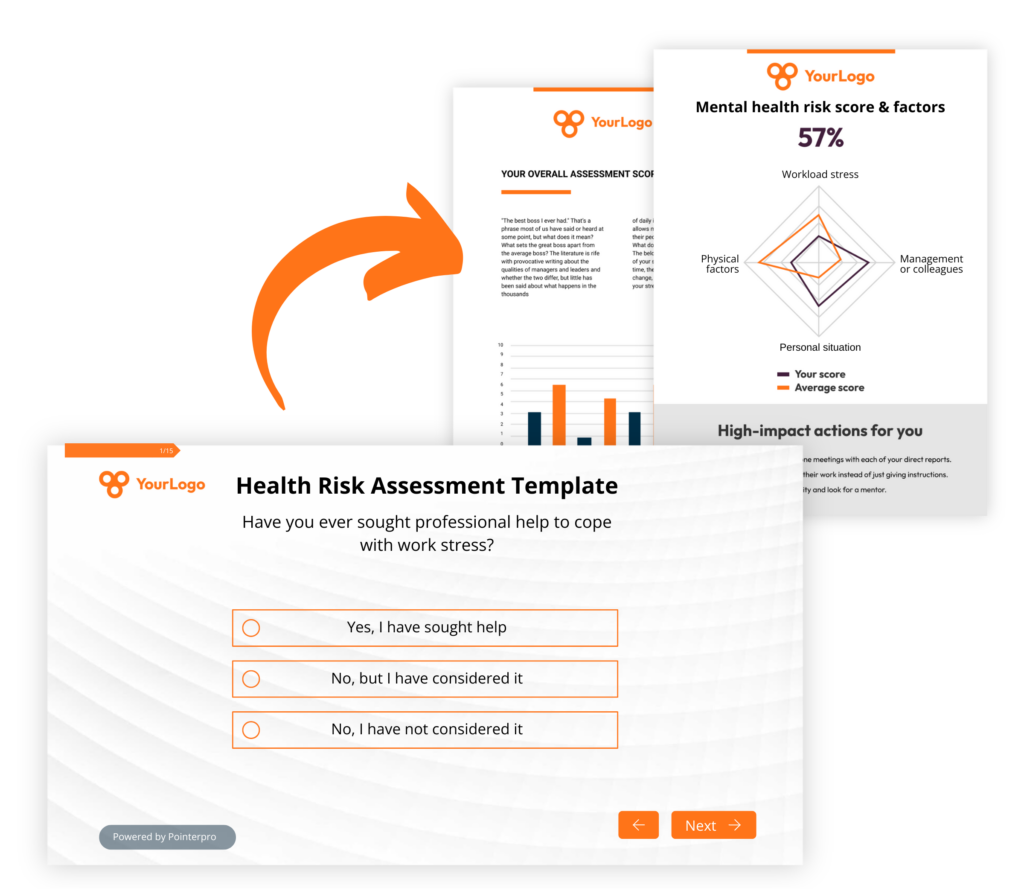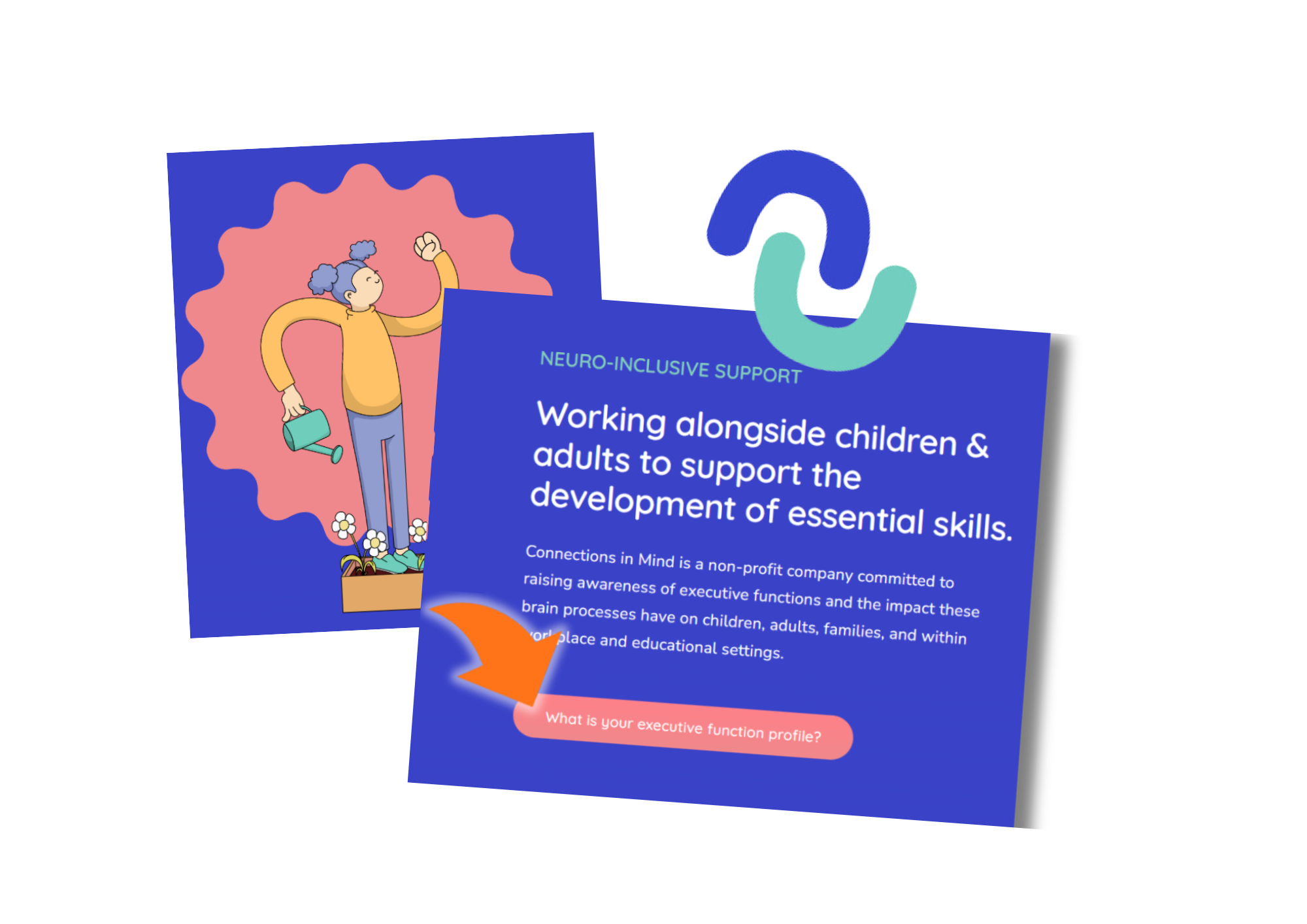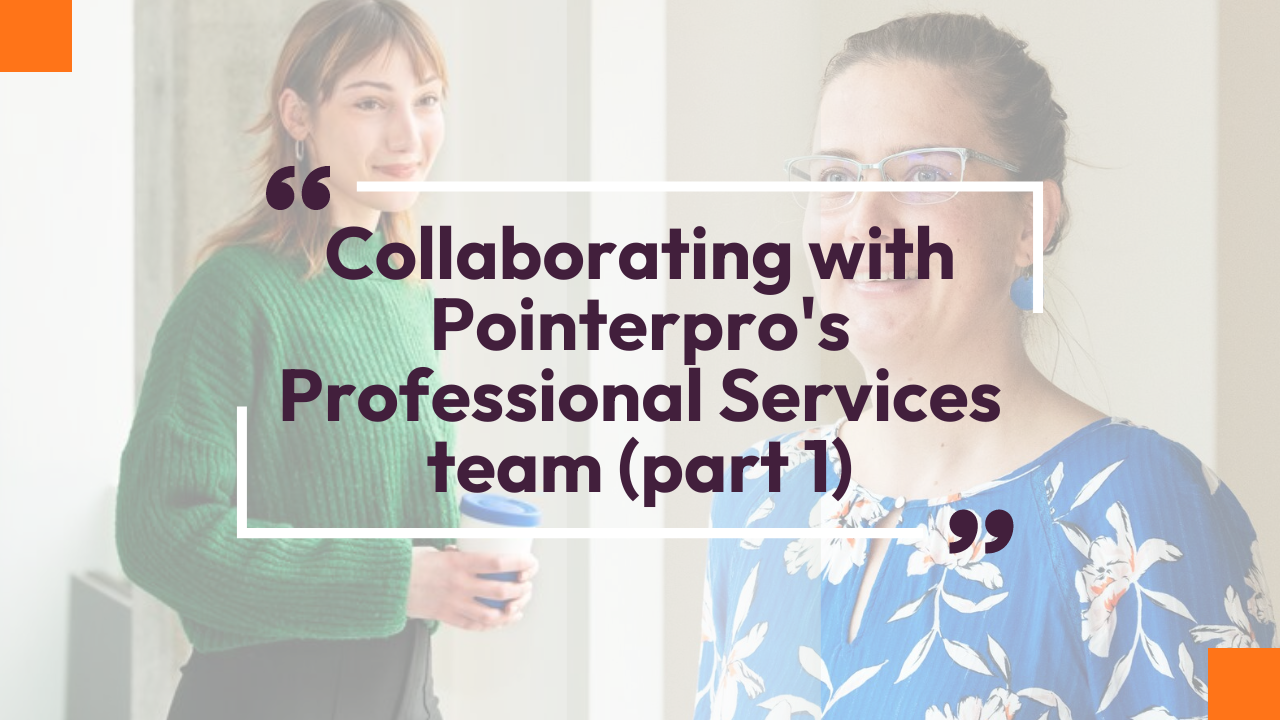Health risk assessment template
Employee health and well-being are more crucial than ever. In uncertain markets, you want people to stay on board and engaged.
With a well-thought-out health risk assessment template, you’re off to a good start. Develop custom assessments for two-way communication now.
Pointerpro is the 2-in-1 software that combines assessment building with personalized PDF report generation.

How to develop an effective health risk assessment tool or template?
A health risk assessment (HRA) tool is a systematic approach to evaluate individuals’ and the overall health status in a company and especially to identify potential risk factors. Though extremely top-of-mind these days, it’s not just about burn-out. A good health risk assessment template encompasses (chronic) diseases, injuries, or any other adverse health outcomes.
It typically involves a series of questions in one or multiple questionnaires related to various aspects of health, such as medical history, lifestyle behaviors, and environmental exposures. It’s extremely important to respect confidentiality and anonymity. One of the primary goals of a health risk assessment tool is to inform your organization’s decision-making related to health promotion initiatives, benefit design, and resource allocation.
A health risk assessment template is a good starting point, but customization is key. Here is why:
- Relevance: Every organization has unique demographics, workforce characteristics, and health priorities. Customizing the assessment ensures that it addresses the specific health concerns and needs of your employees.
- Engagement: Tailoring the assessment to reflect the organizational culture and language can enhance employee engagement and participation, leading to more accurate data and better outcomes.
- Alignment with objectives: Customization allows you to align the assessment tool with the goals and objectives of your organization's wellness program, ensuring that it supports broader strategic initiatives.
- Data integration: By integrating the assessment tool with existing HR systems or wellness platforms, you can streamline data collection and reporting processes, facilitating data-driven decision-making and program evaluation.
3 reasons to use Pointerpro as a health risk assessment tool
3 reasons to use Pointerpro as a health risk assessment tool
Interactive user experience
With the Questionnaire Builder, you get to create an engaging feedback form. How? With numerous design and layout options, useful widgets, and countless question types.
Refined, score-based analysis
Our custom scoring engine helps you quantify and categorize diverse answers. The result? An objective and nuanced health risk assessment that informs your decision-making.
Automated feedback in PDF
Thanks to your setup in the Report Builder, respondents get a detailed individual report with personalized and objective feedback. The organization leaders can get aggregated group reports.
1.500+ businesses worldwide build assessments with Pointerpro









Some tips before you get started on building your health risk assessment
Risk assessment frameworks for mental health to inspire your workplace well-being
Several risk assessment frameworks exist for evaluating mental health risks. Mental health professionals use these frameworks to assess and manage the risk of harm to individuals or others.
Below is a list of commonly used frameworks. While as an HR professional, you may not use these frameworks in their entirety or conduct formal risk assessments like mental health professionals, you can draw on the principles and strategies embedded within these tools to enhance employee well-being, promote a safe and supportive work environment, and effectively respond to mental health concerns in the workplace.
- HCR-20 (Historical-Clinical-Risk Management-20): This structured professional judgment tool assesses the risk of violence and includes historical, clinical, and risk management factors. It helps mental health professionals identify risk factors associated with violent behavior and develop risk management plans.
- SAPROF (Structured Assessment of Protective Factors): Unlike many risk assessment tools focusing on risk factors, SAPROF evaluates protective factors that may reduce the risk of violence or harmful behavior. It helps mental health professionals identify strengths and resources that can be leveraged to mitigate risk.
- START (Short-Term Assessment of Risk and Treatability): Developed for use in psychiatric inpatient settings, START assesses short-term (i.e., 72-hour) risk factors for violence, self-harm, and unauthorized leave. It helps clinicians identify imminent risks and inform treatment planning.
- CARE-2 (Computerized Assessment and Referral System): CARE-2 is a web-based tool used to assess suicide risk in individuals presenting to emergency departments or primary care settings. It incorporates evidence-based risk factors for suicide and provides recommendations for intervention and referral.
- M-PACT (Mental Health Professionals' Attitudes Toward Risk Assessment and Management): M-PACT is not a risk assessment tool itself but rather a framework for understanding mental health professionals' attitudes, beliefs, and practices related to risk assessment and management. It helps identify barriers and facilitators to effective risk assessment and informs training and policy development.
- BROS (Brief Risk-Oriented Scale): BROS is a brief, user-friendly risk assessment tool designed for use in emergency psychiatric settings. It evaluates risk factors for self-harm and aggression, guiding clinicians in making rapid risk management decisions.
These frameworks vary in their focus, complexity, and intended use. Mental health professionals may select and adapt these tools based on the specific context of assessment (e.g., forensic vs. clinical settings) and the nature of the risk being evaluated (e.g., violence, suicide, self-harm). Additionally, ongoing training and supervision are essential to ensure the effective use of risk assessment frameworks in mental health practice.
Risk assessment frameworks for health and safety
Health and safety are, of course, interrelated. Especially in a work environment. That’s why many risk assessment frameworks are commonly used for health and safety management in organizations. These frameworks help identify, evaluate, and mitigate risks to ensure a safe work environment.
Here are some widely recognized frameworks to draw inspiration from:
- HIRA (Hazard Identification and Risk Assessment): HIRA is a systematic process for identifying hazards, assessing associated risks, and implementing controls to mitigate those risks. It involves identifying potential hazards in the workplace, evaluating the likelihood and severity of harm, and prioritizing control measures based on the level of risk.
- Bowtie Analysis: Bowtie analysis is a visual risk assessment technique that depicts the relationship between hazards, threats, controls, and consequences using a bowtie diagram. It helps organizations visualize potential risk scenarios, identify critical control points, and develop robust risk management strategies.
- HAZOP (Hazard and Operability Study): HAZOP is a structured technique used to identify potential hazards and operability issues in process systems, such as manufacturing or chemical plants. It involves systematically examining deviations from design intent and assessing their potential consequences to prevent accidents and ensure operational safety.
- SHE (Safety, Health, and Environment) Management Systems: Various management systems frameworks, such as OHSAS 18001 (now ISO 45001), ANSI/AIHA Z10, and OSHA's Voluntary Protection Programs (VPP), provide guidelines for establishing and maintaining effective health and safety management systems. These frameworks emphasize continuous improvement, employee involvement, and proactive risk management practices.
- FMEA (Failure Modes and Effects Analysis): FMEA is a proactive risk assessment technique used primarily in engineering and manufacturing industries to identify potential failure modes in processes, products, or systems and assess their potential effects. It helps organizations prioritize risk mitigation efforts to prevent or minimize adverse consequences.
- SWIFT (Structured What If Technique): SWIFT is a qualitative risk assessment method that systematically examines potential scenarios and asks "what if" questions to identify hazards, vulnerabilities, and control measures. It fosters brainstorming and collaboration among stakeholders to proactively address risks.
- BIA (Business Impact Analysis): While primarily used for business continuity planning, BIA assesses the potential impact of disruptions or incidents on organizational operations, including health and safety implications. It helps organizations prioritize resources and develop resilience strategies to minimize the impact of disruptions.
These risk assessment frameworks vary in complexity, scope, and applicability to different industries and organizational contexts. Organizations may choose to adopt one or a combination of these frameworks based on their specific needs, regulatory requirements, and risk management objectives.
Health risk assessment example questions
Here are 30 health risk assessment example questions divided into 3 categories
- 10 mental health risk assessment questions
- 10 health and safety risk assessment questions
- 10 public health risk assessment (PHRAT) questions
10 mental health risk assessment questions
- In the past month, how often have you felt overwhelmed or unable to cope with work-related stress?
- Do you experience difficulty concentrating or making decisions at work?
- Have you noticed changes in your sleep patterns (e.g., difficulty falling asleep, waking up frequently) related to work stress?
- How often do you feel irritable or easily angered while at work?
- Do you feel supported by your colleagues and supervisors when dealing with work-related challenges?
- Have you experienced physical symptoms such as headaches or muscle tension that may be related to work stress?
- Do you engage in healthy coping strategies (e.g., exercise, relaxation techniques) to manage work-related stress?
- Have you experienced a loss of interest or pleasure in activities you once enjoyed outside of work?
- Do you feel that your workload is manageable, or do you often feel overwhelmed by the tasks you need to complete?
- Have you ever considered seeking professional help or counseling to cope with work-related stress or mental health concerns?
These mental health risk assessment template questions consider key mental health indicators relevant to the workplace context, such as stress levels, coping strategies, social support, and help-seeking behaviors.
The questions were structured in a multiple-choice format to provide clear and structured response options for participants, facilitating data collection and analysis. A balance of positive and negative indicators has been incorporated to capture both protective factors, such as social support and healthy coping strategies, as well as potential risk factors, such as work-related stress and difficulty in decision-making.
The aim of this approach? Providing a comprehensive assessment of mental health in the workplace while ensuring simplicity and clarity for respondents.
10 health and safety risk assessment questions
- Are you aware of the emergency evacuation procedures in your workplace?
- Do you receive regular training on how to safely handle hazardous materials or substances?
- Have you experienced any workplace accidents or near misses in the past year?
- Are there any physical hazards in your workspace (e.g., exposed wires, uneven flooring)?
- Are safety signs and warnings clearly visible and understandable in your workplace?
- Do you have access to personal protective equipment (PPE) required for your job tasks?
- Are ergonomic factors (e.g., workstation setup, lifting techniques) considered in your work environment?
- Are there adequate measures in place to prevent slips, trips, and falls in your workplace?
- Is ventilation sufficient to minimize exposure to airborne pollutants or contaminants?
- Are there procedures in place for reporting health and safety concerns or incidents?
These health and safety risk assessment template questions evaluate various aspects of health and safety risks in the workplace, covering emergency preparedness, training, hazard identification, physical hazards, safety signage, personal protective equipment, ergonomics, accident prevention, ventilation, and incident reporting.
By using a multiple-choice format, participants can provide structured responses, facilitating data collection and analysis. The questions aim to comprehensively evaluate the organization’s health and safety practices and identify areas for improvement to ensure a safe and healthy work environment.
10 public health risk assessment questions
Health risk assessment templates or tools are not only helpful in the realm of commercial organizations. Public health risks are ever-present. Also after COVID-19. Here’s a list of example questions for such an assessment:
- Have you received vaccinations for common communicable diseases (e.g., influenza, measles) recommended by public health authorities?
- How often do you engage in physical activity or exercise that promotes cardiovascular health?
- Do you have access to clean drinking water and sanitation facilities in your community?
- Have you been screened for common chronic diseases (e.g., diabetes, hypertension) in the past year?
- Are you aware of the signs and symptoms of infectious diseases prevalent in your region?
- Do you practice proper hand hygiene (e.g., washing hands with soap and water) to prevent the spread of infections?
- How often do you consume a balanced diet with fruits, vegetables, whole grains, and lean proteins?
- Are you up-to-date with information and recommendations provided by public health authorities regarding emerging health threats or outbreaks?
- Have you participated in community health promotion activities or initiatives aimed at improving public health outcomes?
- Do you have access to healthcare services and facilities for preventive care and treatment of illnesses?
These public health risk template questions assess various aspects of public health risk factors, including vaccination status, health behaviors, access to clean water and sanitation, disease awareness, and more.
The multiple-choice format allows participants to provide structured responses, enabling efficient data collection and analysis. The questions aim to evaluate individual and community-level factors that influence public health outcomes and identify areas for intervention and improvement to promote better health at the population level.
What Pointerpro clients are saying




What are scenario-based health risk assessments (and why are they useful)?
Scenario-based health risk assessments involve evaluating potential health risks in the context of specific scenarios or situations. Scenario-based assessments typically involve hypothetical scenarios or real-world situations to evaluate the potential impact on health and identify preventive measures or interventions.
Here’s how scenario-based health risk assessments work:
- Identifying scenarios: The first step is to identify relevant scenarios or situations that may pose health risks to individuals or populations. These scenarios could include environmental exposures, occupational hazards, lifestyle factors, emergency situations, or public health crises.
- Assessing risk factors: Once scenarios are identified, the next step is to assess the risk factors associated with each scenario. This may involve considering biological, behavioral, environmental, and socio-economic factors that influence health outcomes within the context of the scenario.
- Evaluating potential consequences: Scenario-based assessments evaluate the potential consequences of each scenario on individual and population health. This may include assessing the likelihood and severity of adverse health outcomes, such as injuries, illnesses, or disease outbreaks.
- Developing mitigation strategies: Based on the assessment of risk factors and potential consequences, scenario-based assessments inform the development of mitigation strategies to reduce or prevent health risks.
Scenario-based health risk assessments offer several benefits:
- Preventive approach: Scenario-based assessments facilitate proactive risk management by identifying potential health risks before they occur and developing preventive measures to mitigate their impact.
- Decision support: These assessments provide valuable information for decision-making by stakeholders, including policymakers, public health officials, and emergency responders, to allocate resources and prioritize interventions effectively.
- Capacity building: By conducting scenario-based exercises, organizations and communities can enhance their preparedness, response, and resilience to health emergencies and other adverse events.
Overall, scenario-based health risk assessments are valuable tools for understanding and addressing complex health risks within diverse contexts, contributing to more effective health promotion, disease prevention, and emergency preparedness efforts.
Create your first health risk assessment today
You may also be interested in
Recommended reading

How Connections In Mind benefits the community interest through a digital mindset and a longitudinal assessment
The fact that communities benefit from diversity should not be news to anybody. One type of diversity you may not

Vlerick Business School digitalizes entrepreneurship development with Pointerpro [case study]
What do a top-tier international business school based in the capital of Europe and Pointerpro have in common? At the

Attain Global: How to do psychometric tests right and build a cutting-edge international business [case study]
In many countries worldwide, the pursuit of skillful and engaged employees is not so much a war on talent as


